Branching Out
Funcom's Trond Arne Aas and Jon Wright discuss the company's new entry into the kids' online space
Yes - you might say that, although we're still convinced there's a high-end MMO market. I think what we've seen on the high-end MMO market is two things: One, it's turned out to be more challenging to keep those big subscriber bases for many years; but on the positive side the sales of new MMOs in the initial launch period are much higher than previously.
So I think what's important is that you really think through that, and that you develop your high-end MMOs with a very open mind. I also think that on the high-end side there are definitely opportunities to test the gameplay mechanics and concepts in a very early phase, before you move into the full production cycle.
I think you'll see that both from Funcom and from other companies in the future, because there aren't that many people that can put down... I don't know how much they're spending on the Star Wars game for example, but it's many tens of millions of Dollars in those big bets. People will be seeking the same kind of risk reduction in the high end space as we've seen in the casual space.

The team has been blessed with some core competence right from the start. It's a mixture of expertise and veterans from Funcom and some new, fresh, very excited young people forming the team.
One of our lead coders for example spent a great deal of time working and learning on Anarchy Online, and gained a great deal of experience on how to deliver a client-server architecture in that environment. Our art director was also the art director on Age of Conan, and brought to the project - which is a small budget, casual project - about 14 years of Funcom experience, and a triple-A art production background, and I can't thank him enough for that.
So really it's a mixture - the other good thing that we have at Funcom are open doors in terms of being able to go and talk to the render coders that are currently working on Conan or The Secret World, and tap their really triple-A, DirectX10, bleeding edge render tech knowledge and not make so many mistakes in the casual space.
It's a real asset having a large skill base to learn from, even though the team itself is relatively small.
Very much so, but it's not just that - it's also all the ancillary systems, like having a good quality QA department, having a great ops team that can give us a good server architecture and experience of how to handle a huge launch like Conan. These are advantages that smaller developers in the casual space probably don't have at their disposal, and I'm lucky enough to have that available on the project.

It's a good question - it was a big focus right from the start that we knew theoretically right from the start that if everything goes well, we get the conversion rates and see the business model working well, it's no-holds-barred on the marketing front... and we need to be able to respond to that.
That's something we were aware of right from the start - just because it's a low development cost game doesn't mean that it won't potentially have millions of people playing it. At a server architecture level, it's ensuring we can bring the servers online rapidly and expand that - which we've done.
To add a new server to our pool is to just flick a switch - it comes on, it finds itself among the other servers and starts sharing its load, and that's without any configuration of anything. So again, some key learnings from Anarchy Online and Conan - Funcom's been doing this a long time, and knows how to deal with it, and we've taken a lot of that into account.
Trond Arne Aas is CEO of Funcom and Jon Wright is producer on Pets vs Monsters. Interview by Phil Elliott.
